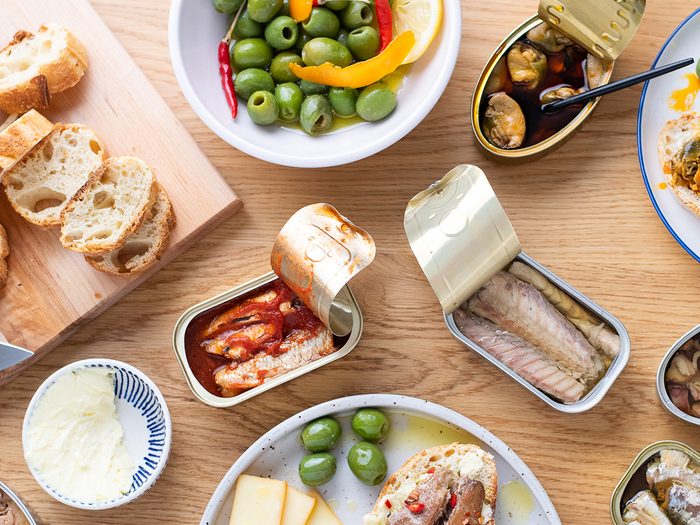Here’s a Good Reason to Buy a Pretty Little Tin of Fish

Fact: Tinned fish is as good for you as its fresh equivalent.
You might be one of those people who wouldn’t touch an anchovy with a 10-foot pole—but if you’ve decided you’re a total tinned fish hater, you probably just haven’t tried the right one. Tinned fish goes well beyond cans of flaked tuna: You can find everything from jalapeño-infused mackerel to silky smoked mussels to lobster meat in lemony olive oil, all in display-worthy packaging. Better yet, these convenient protein sources pack plenty of heart-healthy nutrients into their shelf-stable vessels, proving that, sometimes, the best things really do come in small packages.
The first thing to know about tinned fish is that it’s just as good for you as its fresh equivalent, providing identical omega-3 fatty acids. Tinned fish is also a source of vitamin B2 and vitamin D, which support strong bones and immune function.
Since our bodies can’t actually produce essential omega-3 fatty acids, they are arguably the most important nutrients that tinned fish can provide. Two particularly valuable forms of omega-3s, DHA and EPA, are only present in fish and fish oil, so we need to consume them directly from foods or dietary supplements in order to increase their levels in our bodies. Research has shown that people who consume omega-3s regularly, by eating two or more servings of oily fish per week, reduce their risk for heart disease and stroke. DHA is also important for brain function, and regular intake is thought to help prevent cognitive decline like Alzheimer’s disease or dementia.
Another underrated benefit of tinned fish? Some varieties, like canned salmon and mackerel, are a good source of calcium, thanks to the presence of their tiny bones. (Don’t worry: High-heat cooking during the canning process makes those bones soft, digestible and barely noticeable.) Half a cup of canned salmon contains around 25 to 30 percent of your daily calcium needs—roughly the same as a glass of milk—so it’s a good option for those who don’t eat dairy regularly.
In European countries where tinned fish is a staple, like Portugal and Spain, it can be the star of a dish as often as it can be a background player. But tinned fish newbies can try incorporating small amounts of fish with stronger flavours (like sardines or anchovies) into pasta sauces and salad dressings, or layering them on top of pizza—don’t knock it till you try it! One of my favourite moves is to blend anchovies into softened butter, add in some minced garlic and spread it on a crusty loaf before baking for an umami-packed spin on garlic bread.
Milder, grocery-aisle standards, like smoked mackerel or salmon, can be added to grain bowls and salads for a quick no-cook lunch, or can be turned into easy fish cakes—I love including scallions and grated ginger and serving the cakes with a zippy chili aioli. Smoked mussels work well in a homemade chowder, or you can sauté tinned razor clams in butter, garlic and white wine before scooping onto toasted bread or tossing with pasta for an easy pantry dish. These types of fish do tend to be more pricey, so I find they’re best reserved for appetizers, where their flavour won’t be disguised, or served alongside bread, olives and pickles for a fancy tinned fish spread.
Because cost and proximity to a coastline can be barriers to fresh fish consumption, tinned varieties are an excellent and easy way to get in your protein and omega-3s with minimal effort. Work your way through the tinned fish aisle until you land on one that blows you out of the water.




